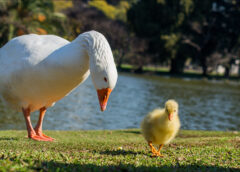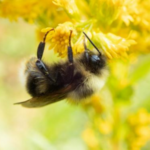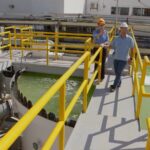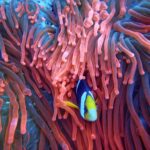Bird Flu, or also called Avian influenza, is caused by a virus that has several strains, some of which are more dangerous than others. Bird Flu is normally found in swans, geese, ducks, and others in the species of migratory waterfowl.
These birds can carry AI without getting sick. As they migrate, they spread the disease to other bird species as well as within their own colony.
According to The Raptor Center at the University of Minnesota, the strain currently being transmitted is a highly pathogenic form of H5N1, which has global agriculture trade impacts for the United States and can have severe impacts on susceptible birds of many species. While waterfowl can carry and shed this virus without any symptoms, birds like domestic chickens and raptors get severe illness and rapidly die. Highly Pathogenic Avian Influenza is spread in the feces and respiratory secretions of infected birds and can be easily transmitted on objects contaminated with virus particles. The virus is tough and can survive cold and freezing temperatures, as well as survive in aquatic environments.
This avian influenza does not pose any risk to humans, and there are no human cases of avian influenza viruses in the United States. But the virus can be deadly in some birds.
The Raptor Center is closely monitoring our local wildlife populations for positive cases of avian influenza and working with other organizations to better understand the current outbreak and help guide the response.
Researchers recommend removing bird feeders and taking steps in discouraging bird gatherings at bird baths.
Hummingbird feeders are not without risk. However, they would pose the lowest risk as they tend to have a much more limited group of birds visiting them. In areas with substantial HPAI transmission consider pausing or, if you continue to use them, clean them on a daily basis to further reduce risk.
Source: The Raptor Center ( University of Minnesota)
Additional Resources:
https://en.wikipedia.org/wiki/Avian_influenza
https://raptor.umn.edu/about-us/our-research/HPAI
- Supreme Court’s EPA Ruling Puts Human Health and Ecology at RiskThe Supreme Court has curtailed the ability of the Environmental Protection Agency to reduce carbon emissions from power plants in a decision that could limit other federal agencies’ regulatory powers. Catherine Kling is an environmental economist and an expert in water quality modeling who served for 10 years on the EPA’s Science Advisory Board. Kling says… Read more: Supreme Court’s EPA Ruling Puts Human Health and Ecology at Risk
- Come Clean for Earth During the Great American CampoutClean Earth Challenge Offers Way to Restore Land, Oceans, Waterways While Enjoying the Great Outdoors RESTON, Va. /PRNewswire/ — To inspire Americans to camp green and come clean for Earth, the National Wildlife Federation is partnering with Johnson Outdoors to launch this year’s Great American Campout. The Great American Campout encourages people to get outdoors and connect with nature… Read more: Come Clean for Earth During the Great American Campout
- Scientists Fail to Locate Once-Common CA Bumble BeesClimate change, urbanization and pesticides imperil wild pollinators Newswise — Several species of California bumble bees have gone missing in the first statewide census of the fuzzy pollinators in 40 years. If they can be found, a recent court ruling could help save them. Smaller-scale studies have documented significant declines in bumble bee populations around… Read more: Scientists Fail to Locate Once-Common CA Bumble Bees
- WATER: We Have Too Much, But Not Enough – To Air On The Science Channel And MotorTrend TVNEW YORK (June 15, 2022) – Water – it’s one of the greatest challenges all nations face today. Though it covers about 71% of the earth’s surface, more than 97% is found in the ocean, unusable for drinking, growing crops and most industrial uses. In fact, less than 3% of the world’s water is fresh, and, of… Read more: WATER: We Have Too Much, But Not Enough – To Air On The Science Channel And MotorTrend TV
- On the 30th Anniversary of World Oceans Day, SeaWorld Announces Commitment to Support UN Sustainable Development Goal 14 ‘Life Below Water’ with Nearly 60 Years of Taking Action to Protect Marine Animals and their HabitatsSeaWorld will continue to act on UN SDG 14 to conserve and sustainably use the ocean, seas, and marine resources SeaWorld has developed and supported various aquaculture programs that reintroduce healthy and abundant fish populations necessary to sustain sea life Restoring coral reef systems has been and remains a priority for SeaWorld in Florida and worldwide SeaWorld will maintain… Read more: On the 30th Anniversary of World Oceans Day, SeaWorld Announces Commitment to Support UN Sustainable Development Goal 14 ‘Life Below Water’ with Nearly 60 Years of Taking Action to Protect Marine Animals and their Habitats








One response to “Bird Flu Outbreak Prompts a Call to remove Bird Feeders”
[…] Bird Flu: http://tnc.network/bird-flu-outbreak-prompts-a-call-to-remove-bird-feeders/ […]